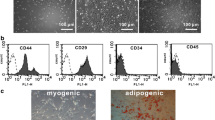Abstract
To investigate whether an erythropoietin (EPO) gene-based therapy could serve as an alternative to the repeated injection of rhEPO in treatment to renal anemia, the genetically modified myoblasts of rats, named Myo/ EPO, were implanted through intramuscular injection to model rats with renal anemia. The hemoglobin (Hb) and hematocrit (HCT) of the rats increased from (92.5 ±3.0) g/L and 0.29±0.04 to the peak values of (103.8 ±5.0) g/L and 0. 32 ±0. 04 respectively 14 d after implantation, and sustained the pre-implantation level for 90 d. Otherwise, the control rats implanted with Myo/X, which carried the parent retroviral vector, gradually became severe in anemia. The PCR detection for hEPO cDNA in the rat muscle adjacent to injection sites indicated that the Myo/EPO cells survived for a long period in the muscle of rats. The results primarily demonstrate that myoblast gene transfer of EPO is effective for the treatment of rat renal anemia.
Similar content being viewed by others
References
Krantz, S. B., Erythropoietin,Blood, 1991, 77: 41.
Naffakh, N., Henri, A., Villeval, J. L. et al., Sustained delivery of erythropoietin in mice by genetically modified skin fibroblasts,PNAS, 1995, 92:3194.
Osborne, W. R. A., Ramesh, N., Lau, S. et al., Gene therapy for long-term expression of erythropoietin in rats,PNAS, 1995, 92:8055.
Setogushi, Y., Danel, C., Crystal, R. G., Stimulation of erythopoiesis byin vivo gene therapy: physiologic consequences of transfer of the human erythropoietin gene to experimental animals using an denovirus vector,Blood, 1994, 84:2946.
Descamps, V., Blumenfeld, N., Villeval, J. L. et al., Erythropoietin gene transfer and expression in adult normal mice: use of an adenovirus vector,Human Gene Therapy, 1994, 5:979.
Liu, Y. X., Wei, H. D., Wu, Z. Z. et al., Characteristics and identification of a rat model induced with adenine diet,Chinese Journal of Nephrology (in Chinese), 1998, 14(1):53.
Qu, C. K., Wei, H. D., He, F. C. et al., hEPO cDNA transfer mediated by retroviral vector and its expression in the primary culture of rats,Chinese Science Bulletin (in Chinese), 1995, 40:2192.
Blau, H. M., Dhawan, J., Pavlath, G. K., Myoblasts in pattern formation and gene therapy,TIG, 1993, 9:269.
Harnamori, Y., Samal, B., Tian, J. et al., Persistent erythropoiesis by myoblast transfer of erythropoietin cDNA,Human Gene Therapy, 1994, 5:1349.
Egrie, J. C., Sickland, T. W., Lane, J. et al., Characterization and biological effects of recombinant human erythropoietin,Immunobiology, 1989, 172:213.
Cynshi, O., Satoh, K., Higuchi, M. et al., Effects of recombinant erythropoietin on anemic W/Wv and SI/SId mice,British Journal Hematology, 1990, 75:319.
Author information
Authors and Affiliations
Additional information
Project supported by the National Natural Science Foundation of China (Grant No. 39470321).
Rights and permissions
About this article
Cite this article
Liu, Y., Wei, H., Wu, Z. et al. Gene therapy for rat renal anemia with implantation of erythropoietin-transgenic myoblasts. Sci. China Ser. C.-Life Sci. 42, 109–112 (1999). https://doi.org/10.1007/BF02881756
Received:
Issue Date:
DOI: https://doi.org/10.1007/BF02881756




